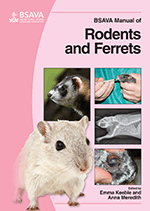
Full text loading...

As a basic rule when dealing with smaller exotics, everything should be treated at least as an urgent case, especially if the animal has already been ill for a while. Clinical signs requiring urgent attention are given in Figure 18.1. In all cases, the owner’s perceptions have to be taken into account. While some may need persuading that their ferret is an emergency case, the opposite situation will also occur. In these cases it is unwise to dismiss out of hand the owner’s opinion that it is an emergency; instead the earliest appointment at mutual convenience should be offered. The principles of examination are similar for all species; this chapters will dwell on features unique to ferrets and special considerations that pertain to them. This chapter explains Handling; History and physical examination; Clinical techniques; Emergency support; Hospitalization; and Euthanasia.
Ferrets: physical examination and emergency care, Page 1 of 1
< Previous page | Next page > /docserver/preview/fulltext/10.22233/9781905319565/9781905319565.18-1.gif

Full text loading...













